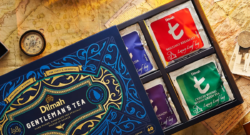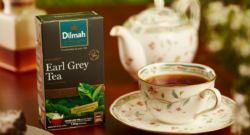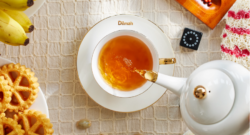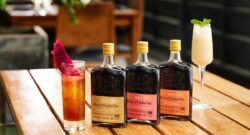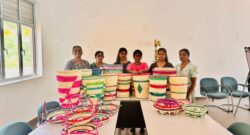Author: Shehani
The Gift That Keeps on Brewing
Gifting can be a daunting task – you want to make it special, enjoyable and memorable for the recipient, but you can’t help but wonder if what you’ve picked ticks all the boxes. Which is why we at Dilmah come up with the most novel gifting ideas every now and then, giving you a vivid choice of tea gift packs that you could present to family and friends, both locally and abroad. Tea in itself is one of the healthiest beverages that one could enjoy, at any time of the day. If we look at it in a scientific sense, the nutritional benefits, antioxidant activity, benefits to oral health and contribution towards lowering the risk of non-communicable diseases are unparalleled in the world of beverages. On top of this, Dilmah offers a spectacular range of premium Ceylon teas, flavoured teas and infusions, which we have thoughtfully assorted into gift boxes of various quantities and appearances. There are packaging varieties to go with different occasions and seasons – Christmas, Valentine’s Day, Ramadan, Easter, spring, winter, something to say a little thank you, and something for just about any celebration under the sun. Dilmah also offers the unique option of personalising our Gentleman’s Tea gift pack, to add an element of splendour and surprise for the recipient. Should you wish to completely customise your gift, you could pick a trio of tin caddies from our multitude of t-Series varieties that come in both loose leaf and gourmet tea bag forms, and present them in our eye-catching gift boxes. If you’re looking for something a little more elegant and refined, we’ve got our very own wooden presenters, too, in which you could gift your selection of teas, as well as a collection of striking tin canisters with region-specific single origin teas that you can choose from. What’s more, Dilmah now also offers the Ceilão gift pack that has two of Sri Lanka’s most valued and beloved commodities – Ceylon tea and Ceylon cinnamon. A match made in heaven, to be enjoyed together or by themselves. In short, you’ll never find yourself short of gifting options with Dilmah. In fact, our online retail store and our tea boutiques and tea shops at t-Lounge by Dilmah outlets in Colombo will leave you nothing short of spoilt for choice.
Earl Grey – The Inspiration Behind a Beloved Brew
Charles Grey, the 2nd Earl Grey from the House of Grey in England, served as Prime Minister of the United Kingdom between 1830-1834. It is widely believed that the Earl Grey tea enjoyed by many around the world is the namesake of this noble gentleman. As to how and why there came to be a tea named after him is not a definitively established fact. However, there are several theories that can be deemed as plausible reasoning behind the moniker. One theory is that the tea was presented to the Earl in 1803, by a Chinese mandarin (bureaucrat scholar) as a token of gratitude for the Lord Grey’s men saving the life of his drowning son. An alternative legend with a more political philosophy is that Earl Grey was gifted the tea as a diplomatic compensation for his role in ending the East India Company’s monopoly on trade between Britain and China. In another account, the Grey family claims that the brew was specially created by a Chinese mandarin for Lord Grey to counter the overbearing presence of lime (calcium oxide) in the water at Howick Hall, the family seat in Northumberland, England. Regardless of which theory or legend is true, we’re certainly glad that Earl Grey tea exists for our enjoyment, to date! So, what is in Earl Grey tea? Bergamot oil is the not-so-secret ingredient that makes Earl Grey tea what it is. It is derived from the bergamot orange (Citrus bergamia), which is believed to be a hybrid between lemon and bitter orange. Predominantly native to the Mediterranean region – large-scale cultivation of the small-sized tree is found in the coastal province of Reggio di Calabria in Italy, and is also found in lesser volume in parts of Greece, Turkey, France, Algeria, Morocco, Tunisia, Argentina, Brazil and some parts of South East Asia. The essence that is used in the production of Earl Grey tea is obtained from the peel of the bergamot fruit, which gives the resulting brew its unique citrusy-floral aroma and rejuvenating taste. In fact, so aromatic and charismatic is the essence that it is widely used in the production of perfumes, and is a key component of the original Eau de Cologne that was created by Johann Maria Farina in Germany in 1709. Bergamot essence is also frequently used in the making of Turkish delight. Dilmah’s Tributes to Earl Grey If you haven’t already tried any of Dilmah’s Earl Grey teas – bergamot infused into the finest Ceylon tea – then, right now’s the time to make it happen. There’s a variety to pick from, extending from our standard range to our more exquisite ranges such as Dilmah Exceptional, Dilmah Vivid, Dilmah YUM, Silver Jubilee, 85 Reserve, and The Teamaker’s Private Reserve. You’ve also got the options of standard tea bags, gourmet pyramid bags and loose-leaf tea, and a couple of Earl Grey with vanilla options to choose from. Find out more about these teas and place an order for your preferred Dilmah Earl Grey tea here.
What Does ‘Avurudu’ Mean to Us?
Avurudu (Puththandu in Tamil), the Sinhalese and Tamil New Year that is usually celebrated around the 13th and 14th of April, is one of the biggest festivals on the Sri Lankan calendar. While primarily celebrated by the Sinhalese Buddhist and Tamil Hindu communities, it is quite the norm for most Sri Lankans around the globe to join in the festivities. Even those who don’t follow the traditions of the festival partake in the fun and games, and most certainly enjoy the sweet treats of the season. In an astrological sense, Avurudu is the movement of the sun from the House of Pisces (Meena Rashiya) to the House of Aries (Mesha Rashiya). It also marks the end of the harvest season and of spring. The intermediary ‘neutral’ period, referred to as nonagathe in Sinhala, is somewhat of a ‘dead’ phase where people refrain from doing anything of significance. In a traditional sense, Avurudu is all about new beginnings, with most Buddhists and Hindus following strict auspicious times calculated by astrologers to celebrate the dawn of the new year, light the traditional oil lamp, boil milk, cook kiribath (milk rice), bathe, have their first meal, commence work in the new year, and so on. It’s a time to pursue new hopes and dreams, and to amend and make peace with anything that might have not gone too well in the old year. In a cultural sense, Avurudu is a time that brings all Sri Lankans of every race and religion together. Often, those who live away from their ancestral or parental homes return home to spend time with their family and friends. At these gatherings, old and young ones alike participate in various traditional Avurudu games that range from tug-of-war to sack races, kotta pora, pinning the eye on the elephant, lime-and-spoon races, bun-eating competitions and so much more. The implications of these activities go beyond simply having fun, for they nurture unity and relationships, giving everyone something to look forward to enjoying with one another. No celebration is complete without good food, and Sri Lankans certainly have a habit of going all-out to lay a spread of special (and indulgent) specialities that everyone instantly craves when they think of Avurudu. There’s the brand ambassador-like, unmissable trio of kavum, kokis and mung kavum, the pop-in-your-mouth-any-time milk toffee, coconut rock, semolina toffee and kiri aluwa, the demurely satisfying halapa and aggala, and the delightfully messy aasmi. The great news is that t-Lounge by Dilmah in Colombo is dishing out all these sweet treats this Avurudu season – as a Mini Kevili Plate of kavum, kokis and mung kavum to enjoy at any of the three outlets (Horton Place, Chatham Street, One Galle Face Mall), or in the form of Handy (Hurubuhuti) or Large (Dewantha) Kevili Hampers that contain all (yes, ALL) of the above-mentioned Avurudu treats. The hampers are great to serve at home or to gift, and need to be pre-ordered. Apart from these, t-Lounge by Dilmah has also got a few Avurudu-themed 1kg and bento cakes that are equally great to serve or to gift. Check out @teatimerocks on Instagram to make your pick! Of course, at Dilmah, no festivity would be complete without Ceylon’s finest tea. So, we’ve designed the most beautiful and intricate wooden box, inspired by traditional Sri Lankan woodwork, that we think would make the perfect gift for absolutely anyone this Avurudu season. It’s called the ‘Sri Lankan Woodcraft-inspired Dilmah 6-Slot Gift of Tea’ and can ideally hold six varieties of your favourite Dilmah teas and infusions. This, too, can be purchased exclusively at any of the above three t-Lounge by Dilmah outlets. On that note, we would like to wish all of our community – our extended Dilmah global family and friends – a happy and prosperous Sinhalese and Tamil New Year! සුබ අලුත් අවුරුද්දක් වේවා! புத்தாண்டு வாழ்த்துகள்!
World Health Day Week: Talking Tea
There is a strong undercurrent driving people towards ‘healthy living’ of late – for good reason, of course. The world is becoming more and more instant and automated, whether we talk about food, work, travel or chores. So, the need to consciously make an effort to improve our lifestyle and diet has become all the more accentuated and, inadvertently, complex. There’s an increasing demand to figure out what the best diet is for your body type, what the best workout is for your lifestyle, what the best practices are for your mental health, and so on. While you’re figuring all of this out – and while it’s still World Health Day Week – we thought we’d offer you a little more insight into how our favourite herb, Camelia sinensis, could give you some support on your health journey. We’ve already talked about the positive impact of antioxidants in tea on overall well-being, and how tea can boost oral health, in previous posts. So, let’s take a look at some non-communicable diseases (NCDs) that drinking tea could contribute towards keeping at bay or alleviating. Diabetes Tea can help prevent the incidence of diabetes both directly and indirectly. Direct contribution may occur by reducing the absorption of glucose from the digestive tract into the bloodstream, and by increasing the effectiveness of insulin after a meal. Indirect contribution may occur by reducing inflammation and obesity, both of which are risk factors for diabetes. (Ref: Tea and Your Health by Prof. Tissa Amarakoon*) Cardiovascular Disease (CVD) Tea is known to reduce oxidative stress and blood cholesterol levels, as well as to reduce the risk of high blood pressure, chronic inflammation, blood clotting and diabetes. All of these are significant risk factors for CVD. Hence, by reducing the risk of these conditions, tea drinking naturally lowers the risk of developing CVD. (Ref: Tea and Your Health by Prof. Tissa Amarakoon*) Stroke By lowering the risk of blood clotting and other conditions mentioned above, drinking tea could also the risk of stroke and subsequent complications such as paralysis. (Ref: Tea and Your Health by Prof. Tissa Amarakoon* Cancer Research shows that regular consumption of tea could help to reduce the risk of certain types of cancer (oral cavity, thyroid, nasopharynx, lungs, gall bladder, gastric system, biliary duct, prostate, and ovaries, and recurrence of breast cancer). This is mostly linked to the action of flavonoids present in tea, which can act in several ways to counter the initiation or progression of cancer. These mechanisms include neutralising carcinogens that could cause DNA mutations, by interfering with the mechanism by which cancer cells can evolve into malignant tumours, and by reducing metastasis (spread of cancer to other parts of the body), thereby increasing the effectiveness of treatment. (Ref: Tea and Your Health by Prof. Tissa Amarakoon*) *If you would like to learn more about the science behind the health benefits of drinking tea, click here to get your own copy of Prof. Tissa Amarakoon’s comprehensive compilation – Tea and Your Health.
Dilmah HQ’s Elixir of Ceylon Tea Takeover
The Cambridge Dictionary defines elixir as “a substance, usually a liquid, with the magical power to cure, improve, or preserve something”. That’s exactly what Dilmah Elixir of Ceylon Tea is. Well, sort of… The official product description states that it is a ‘natural extract of hand-picked Ceylon tea for iced tea, infused water, tea mixology, tea shakes and smoothies’ – which sounds pretty magical in itself. What this essentially means is that, in these elixirs, we’ve got the natural health benefits that come from Dilmah’s single origin Ceylon tea, with its antioxidant-rich composition, as well as a rich versatility in terms of how the humble tea leaf can be enjoyed for its goodness and flavour, in a wide array of dishes and beverages. What’s more, there’s a sensational range of Dilmah Elixir products to play around with – from black tea extract with mango flavour, peach flavour, almond flavour, ginger and apple flavour, rose and vanilla flavour, and lychee flavour, to green tea extract with jasmine flavour. The possibilities are limitless and truly stimulating for the creative and innovative nook of one’s brain! If you look through our database of tea-inspired recipes, you will find an endless number of food and beverage recipes that have used Dilmah Elixir of Ceylon Tea in the most novel and unexpected ways. Bearing this in mind, we asked a few of our Dilmah HQ family to share the inspiring ways in which they incorporate the magical elixir into their favourite casual bevvies at home. So far, we’ve got a zesty banana smoothie recipe with Dilmah Elixir of Ceylon Tea Lemon and Lime Flavour from Sharmilla Rosa, a kid-friendly mocktail recipe with Dilmah Elixir of Ceylon Black Tea with Mango & Lychee by Nishanthi Amaratunga, and a tropical fruity cocktail recipe which gets its kick from Dilmah Elixir of Ceylon Back Tea with Amaretto Royale from Jerome Auvity. Check out the recipes and tell us what you think – or share your own!
Your Ultimate Rest with Sleepmaxxing
Sleepmaxxing is definitely #trending. It’s the phenomenon of aligning every possible aspect so as to potentially optimise the amount of sleep one gets. There are some factors that most of us are already familiar with, and there is a science behind each of these. Let’s take a closer look at a few. Unplugging from screentime. Melatonin is a hormone that is actively involved in regulating sleep by helping the body to wind down and relax. The blue light emitted from screens of electronic devices is known to suppress melatonin production in the body. It is therefore recommended that we unplug from electronic devices about 45-60 minutes prior to going to sleep so as to help prepare both mind and body for better sleep. Sticking to a routine. Maintaining a routine schedule where you go to sleep and wake up at around the same times every day can help the body to keep its circadian rhythm (the body’s internal clock that regulates sleeping and being awake) in check. Catching some morning sunshine. Exposure to a bit of sunlight – natural light – in the morning also contributes towards maintaining one’s circadian rhythm by signaling to the mind and body that it’s time to awaken, arise and reset for a new day. Having a suitable sleep environment. The body sleeps best when the body is comfortable. The ideal temperature for good sleep is believed to be between 15.6oC and 20.0oC. Of course, this could vary based on individual preference. Other factors that contribute towards good sleep ‘hygiene’ include having a silent sleeping space, dim or no lighting, a soft mattress and pillows with frequently changed bed linen, and feeling clean and fresh before getting to bed. Deep breathing and meditation. Meditation or simple deep breathing can help to relax the mind and body, and create some relief from anxiety and stress. The calming effect thus brought about can help attain better sleep than if the body and mind are tense or stressed. Being mindful of what you consume before bedtime. We have heard plenty about avoiding caffeine consumption before bedtime. However, did you know that consuming herbal infusions such as chamomile flowers can also help to relax your nervous system by acting as a natural mild sedative? The subsequent reduction of anxiety and induced relaxation can contribute towards giving you a good night’s sleep. And this is where Dilmah steps in. Dilmah offers a premium selection of 100% natural chamomile flower infusions, available at Dilmah Tea Boutiques in Sri Lanka and at our global shop online.
Weaving Empowerment into Communities
Give a man a fish and you feed him for a day. Teach him how to fish and you feed him for a lifetime. That is empowerment… To reinforce someone with the skill set to earn their own means. The MJF Charitable Foundation (MJFCF) partakes in many initiatives to empower various branches of society including differently abled children, underprivileged youth and marginalised women. The beautiful hand-woven items that you see throughout this article are the result of such an initiative carried out by the MJFCF’s East Centre Women’s Development Programme in Kalkudah. Fifteen keen female residents in the area were trained and equipped with the new skill of palmyrah leaf weaving. Since the main resource for this practice is the palmyrah tree, which is widely available in the Kalkudah region, it is a skill that is convenient and practical for them to put into use. They could focus on tapping into their inherent creativity and intelligence to learn the craft of neatly weaving the leaf into whatever item they intended to make, without having to worry about sourcing raw materials. On the 29th of January (2025), the entrepreneurs-in-the-making were given the opportunity to showcase their newly-acquired skills to a visiting team from Dilmah’s Head Office. In fact, it was more than just an exhibition – the ladies made a total sale of LKR 23,350 on the day, with the Head Office crew being highly impressed by the variety and quality of items that these women had created in such a short time. It was truly awe-inspiring. There were baskets, market bags, trays, place mats, tissue box holders, storage boxes, food utensils, other homeware items, and even garlands! The MJF West Centre in Moratuwa has already placed orders for several items made by these incredible women, and they have also been allocated stalls at the next People’s Market in the East. The icing on the cake is that all of these palmyrah leaf items are environment-friendly, hence inadvertently enabling these women to educate, promote and contribute towards sustainability among their communities as well – an aspect that Dilmah Conservation and the MJF Group strongly advocates. If these images are anything to go by, the trainees are certainly well on their way to becoming fully-skilled entrepreneurs! Stunning, isn’t it, what empowerment can do?
Enhancing Childhood Learning through Reading
“The man who does not read good books is no better than the man who can’t.” – Mark Twain, author – Sri Lanka prides itself in having a literacy rate of around 95% among the segment of its population that is over ten years of age. However, a high literacy rate can only mean so much if there is little access to constructive reading material that nurtures young minds and keeps older minds agile. Reading and storytelling are essential contributors towards childhood learning, when a child’s mind absorbs every new practice and piece of information that they are exposed to. Tuk Tuk Library The COVID-19 pandemic was a bleak phase for children, as much as it was for adults. Schools were closed and children in underprivileged communities had no access to education or reading material. It was during this time that the MJF Charitable Foundation (MJFCF) stepped in with a brilliant idea to address this issue – the Tuk Tuk Library. Essentially a mobile library on (three) wheels, the Tuk Tuk Library made weekly visits to poverty-stricken areas in the town of Moratuwa, taking books, toys and games for children to engage with and fuel their minds. The whole project was conducted in keeping with health and safety protocols at the time, which meant that it needed much thought and commitment. However, it was totally worth it, for no mask could hide the spark in the eyes of the kids as they rummaged through each week’s offerings and made their picks. For them, it was a joyful splash of colour in a world that had turned monochrome. In fact, the MJFCF Tuk Tuk Library continues to buzz around today, having expanded its reach to more communities across Sri Lanka, to enrich more and more young minds. In addition, the Tuk Tuk Library also visits elders’ homes where residents eagerly await the newspapers, books and games that are brought for their perusal. Monthly Book Reading Over the past few years, the MJFCF has also been carrying out Monthly Book Reading sessions for children over the age of three years at the Moratuwa Community Library. Each month, the team selects a different theme – often celebrating or highlighting a significant event for the month, such as World Oceans Day in June, World Chocolate Day in July, and the likes. The sessions are conducted in a relaxed, child-friendly environment and involve engaging the children in an hour of having stories read to them by a volunteer, interacting during storytelling, and sometimes even learning new skills pertaining to the theme. The Monthly Book Reading sessions not only help children to expand their vocabulary and use of language, but also helps them in developing the ability to pay attention and stay focused on a particular subject while the reading is going on. The interaction that follows further helps them to develop their power of recollection of details that have been conveyed to them, as well as to augment their sense of creativity, communication skills and social interaction. They are also provided with a safe space to express their thoughts and emotions on the theme being discussed and beyond. All of these are important exercises that contribute significantly towards the childhood learning process. Wondering How You Can Contribute? Now that you know what initiatives the MJFCF has taken to enable and encourage reading among kids to enhance childhood learning, here are a couple of ways in which you, too, could contribute: For more information on how you can be a part of these initiatives, email info@mjffoundation.org or DM @mjffoundation or contact us on +94 77 250 7879.

